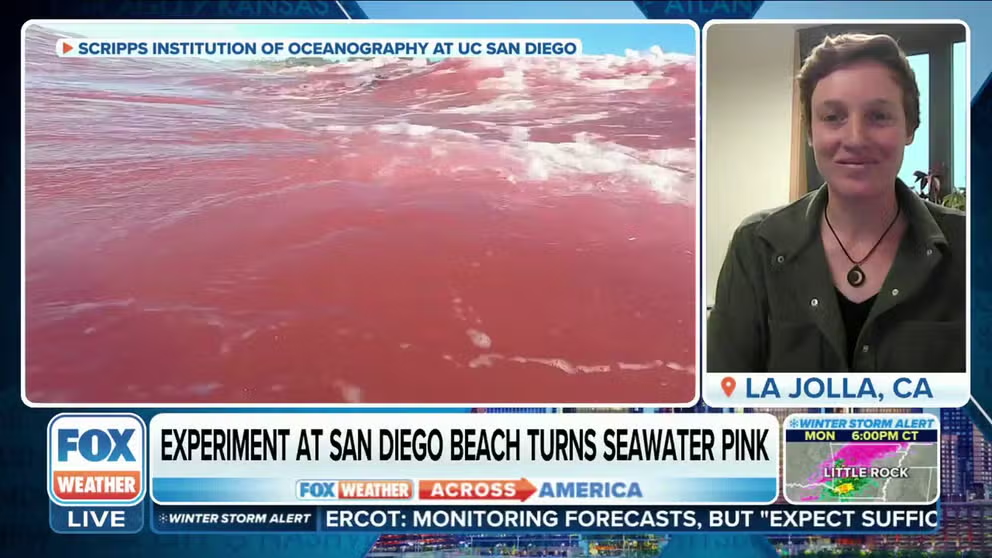Ocean research tickled pink: Scientists color California waves to study coastal interactions
Using environmentally-safe dye, the UC San Diego’s Scripps Institution of Oceanography and the University of Washington team are turning some California coastal waters pink.
University Dyes Seawater Pink For Experiment
Dr. Alex Simpson from the Scripps Institution of Oceanography at UC San Diego joins FOX Weather to discuss their experiment tracking ocean currents through dying seawater.
SAN DIEGO -- Beachgoers along a California state beach may have done a double take when they stepped onto the sand recently and saw pink waves rolling onshore.
The unusual pink hue at Torrey Pines State Beach and Natural Reserve wasn't an art installation gone wrong but an environmentally-safe dye deployed by a team of researchers at UC San Diego’s Scripps Institution of Oceanography and the University of Washington.
The National Science Foundation-funded study aims to learn how freshwater plumes from estuaries interact with the ocean environment when they collide, specifically with breaking waves, according to a news release.
Ocean researchers turn California state beach pink to learn about coastal ocean dynamics
Researchers at UC San Diego’s Scripps Institution of Oceanography and the University of Washington are using pink-hued dye to study how small freshwater outflows interact with the surfzone. The pink-tinted waves could be seen in January at Torrey Pines State Beach in California.
"The results of this study will provide crucial data for quantifying the spread of sediment, pollutants, larvae, and other important material in the nearshore environment," according to Scripps Oceanography.
RELENTLESS PINEAPPLE EXPRESS STORMS DECIMATED CALIFORNIA'S EARLY ELEPHANT SEAL PUP POPULATION
Beginning on Jan. 20, the Plumes in Nearshore Conditions, or PiNC, research team released fluorescent pink dyes in the estuary and surrounding coastline at Los Peñasquitos Lagoon within the state beach. The dye helps track the processes when plumes meet the surf.
To monitor the freshwater plume interactions, researchers used drones to survey from above and watched the pink water from the ground and in the water on jet skis for about 24 hours. The team also uses sensors on the sea floor and moorings to measure ocean currents, and wave heights and collect other data.

The first pink dye release at Los Peñasquitos Lagoon resulted in visible pink waves and seawater at Torrey Pines State Beach. (Photo: Alex Simpson/UC San Diego)
A new drone system is observing the plumes with a camera "that has nearly 100 times the capability to distinguish the visible light spectrum than our phone camera," Research team member and Scripps postdoctoral scholar Alex Simpson said.
While the pink tides were in the name of science, the above views were also beautiful.
Researchers chose Los Peñasquitos Lagoon because other studies have focused on large-scale freshwater plumes. The lagoon provides an excellent small river plume example to study.
HOW TO WATCH FOX WEATHER ON TV
"Los Peñasquitos Lagoon is a very dynamic system, with different elements changing each day, often even over the course of one day," Simpson said. "I am looking forward to seeing how the balance of physical forces—ocean waves competing against river outflow—determine the fate of the estuary water as it enters the coastal ocean on the days that we conduct our field experiment."

Pink waves at Torrey Pines State Beach on Jan. 20, 2023. (Photo: Erik Jepsen/UC San Diego)
Even though the dye is non-toxic, beachgoers have been asked to use other parts north or south of the estuary on release dates because of the active research.
WHY ATMOSPHERIC RIVERS COULD BECOME MORE FREQUENT AS WORLD TRANSITIONS OUT OF LA NINA
This isn't the first time science has been tickled pink. A 2015 experiment by Scripps Oceanography scientists was used to track beach pollution dynamics near the U.S.-Mexican border with pink dye.
The experiment is set to run through February with two more dye releases.

